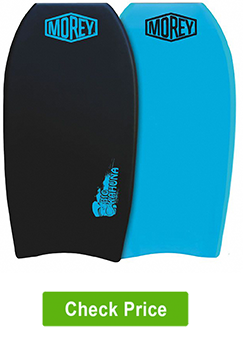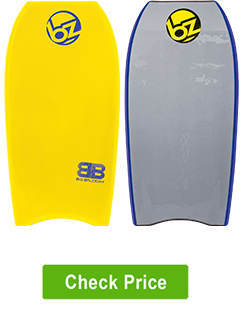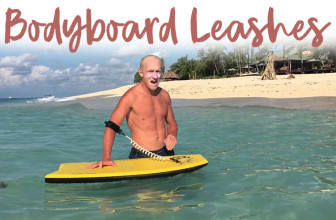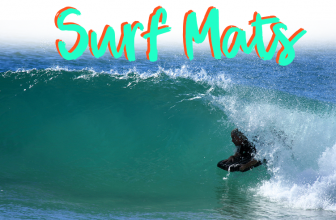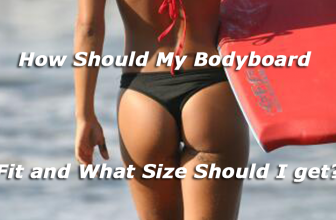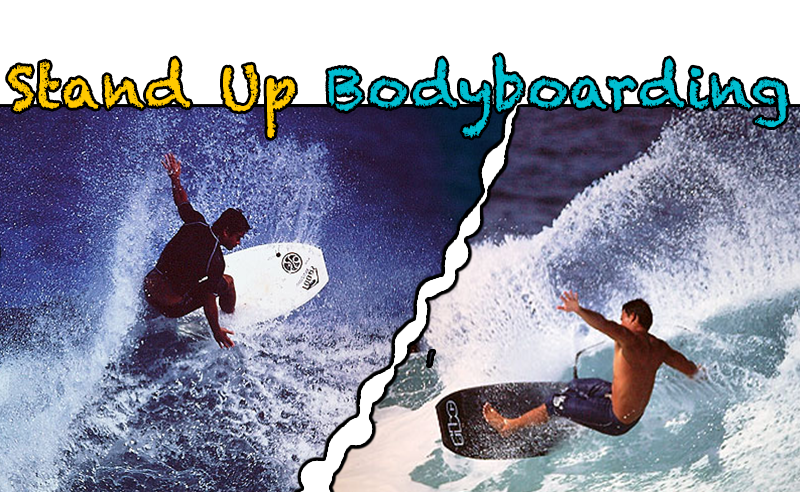
Try It – You May Like It
More popular in the 1980s and 1990s, standup bodyboarding is still around. Combining surfing and bodyboarding, this type of wave riding is a bit more challenging.
More...
Because you and the bodyboard you’re riding do not have stabilizing fins, you have no fin boost to get into a wave and the board tends to significantly slide sideways on the wave face.
Nonetheless, it is a fun way to surf waves and definitely worth learning.
Let’s look at getting you started if you’re willing to give it a try.
The 4 Best Standup Bodyboards
Made for the big rider that stands 5’10” or taller in height and weighs heavier than 185 pounds.
The board’s strength is derived from a unique, high quality and high-density dual composite carbon stringer, which adds a solid foundation to the bodyboard and improves its stability.
It’s reliable and exceptionally hardy right down to its polyethylene core made from medium density, closed-cell foam of strong-bonding polymeric chains that make this board suitable for both warm and cold water use.
A high-density polyethylene slick bottom gives you speed, and its crescent tail and channeled bottom offer a smooth, controlled ride down the line.
The Beater Boards by Catch Surf are ideal for those people who have never surfed, have limited surfing knowledge, or are teaching others to surf. The board has a soft-top to make the transition from flat to standing easier.
With this board, you can go finless or add a single fin or twin fins. These boards make the most of small, mushy summer waves, shore dumping waves, and beach breaks. Several models are available that include 48” and 54” tall boards.
Thick maple plywood stringers increase strength and rigidity, a dual-channeled crescent tail provides finless stability, and the tapered D-rails maximize interaction with the waves.
These boards are lightweight, made with a water resistant, dual-composite core, have a polyethylene deck and high-density, polyethylene slick skin.
This board is unique among boards used for standup bodyboarding for multiple reasons.
It is built exceptionally strong to handle the hefty (over 220 pounds) or overly tall (over 6’) person, yet it floats like a longboard and maneuvers like a short board.
The sides are curved but less so than other bodyboards, giving a lot of speed on the waves with more control for the rider.
With dual Variable Flex Stringers (VFS) patented by BZ, an innovated nose grip lip, and BZ’s exclusively blended version of a polypropylene core called Zero-G, this board is unbelievably durable and strong yet flexible and snappy to ride.
These features – strength and agility – along with being unbelievably light in weight, are monumental to making this a high-performance board. Other features include a comfortable Premium Wave Cushion Air NXL deck, a high-density polyethylene slick bottom with channels and a crescent tail design.
Last, if you’re average in size and weight, this board will work incredibly well for you also.
How To Stand Up On A Bodyboard
Like surfing, you are not wearing fins on your feet. Like a bodyboarder, you do not have fins on your board.
Like both of these activities, you need to learn to read waves and get into the position to catch them.
Paddle for a wave primarily with your arms and kick with your legs.
As the board catches, place the heels of your hands along the rails of the board just under your chest and do a push up with the upper body, and press down evenly with both hands to keep the board stable.
In one swift move, snap/lift your lower body off the board with your hips, and use your core to tuck your body and swing your legs beneath you as you would for surfing. Placement of the feet is key also in that one foot is more forward than the other and each point more toward the rail, like in surfing, but stay fairly close together.
As soon as the feet are in place, let go of the board and stay in a deep squat position until you feel balanced, then stand up all the way. Maneuvering relies heavily on hip and heel weight being more on the tail end, just like on a surfboard.
FAQ
How hard is it to learn standup bodyboarding?
If you already know how to surf, or you already know how to bodyboard, that’s a great start. If you’re skilled at doing both, even better! If you don’t know how to do either, that’s ok too. It just means that your learning curve is higher and it will take more time, patience, and practice.
Do I need a leash for a standup bodyboard?
No, however, if you’re riding larger waves or are in an area with a lot of current, a leash is not a bad idea.
Do I need to wax my standup bodyboard?
You don’t have to but it sure will help keep your feet from slipping out from beneath you when popping up and on maneuvers. Instead of waxing the entire board like a surfer, however, only wax the rails where your hands will go and the section of the board where you place your feet.
Can my standup bodyboard break?
Any surfing-type board is susceptible to breaking. Surfers can easily snap a longboard or short board in half on a big day if a powerful enough wave hits it in just the right spot. Bodyboarders can break boards when they twist their bodies too hard into their turns. Always inspect your gear and get boards suited for your body weight and type of waves you’ll be riding.
Standup bodyboard versus Regular bodyboard?
Standup bodyboards are typically narrower, longer and more similar to surfboards. It’s the stringers that keep the board stiff yet flexible, and standup boards will have stronger or more stringers embedded in it.
Do you wear fins with a standup bodyboard?
You and your board are completely finless. When standing up, the body lifts out of the water so the legs can swing beneath you. Foot placement is the key to remaining balanced on the board and fins would only get in the way of this deft piece of footwork.
What kind of waves do you ride with a standup bodyboard, anything in particular?
Any type of wave is okay, but for learning, small, knee-high waves are best. Once you acquire the skills, try bigger waves.

